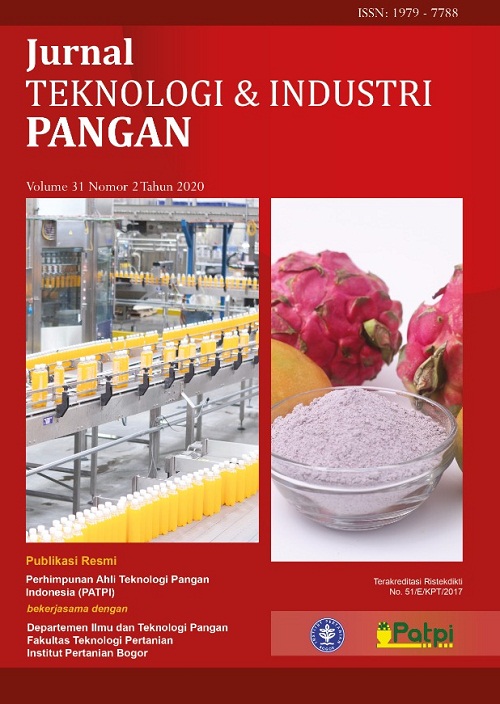STABILITY OF CHITOSAN-TRIPOLYPHOSPHATE COMPLEX-ENCAPSULATED ANTHOCYANIN AT HIGH WATER ACTIVITY
Abstract
Previous study successfully conducted encapsulation of the purple-fleshed sweet potato’s anthocyanin but the study has yet to reveal the stability of encapsulated anthocyanin. Therefore, this research aims to observe the stability of encapsulated anthocyanin regarding the characteristic of low anthocyanin stability, which depends on environmental factors, such as temperature, pH, humidity, and water activity. The kinetic parameters of stability, including kinetic constant (k), reaction order, and half-life (t1/2), were also studied. Stability testing was conducted in high water activity of 0.75 and various in-cubation temperatures at 16, 25, 35, and 45°C. Un-encapsulated anthocyanin extract was also tested for its stability in the same condition in order to be compared with encapsulated anthocyanin. This study re-vealed that the encapsulated anthocyanin had lower stability than un-encapsulated anthocyanin extract. It was proven by higher kinetic constant and lower half-life of encapsulated anthocyanin for every incubation temperature which was induced by higher pH of encapsulated anthocyanin compared with anthocyanin extract. Besides, high water activity reduced glass transition temperature (Tg), in which encapsulated anthocyanin was in rubbery state. Both encapsulated anthocyanin and anthocyanin extract were degraded following the first order kinetic. Using the Arrhenius equation, it was obtained that the degradation kinetic constant of encapsulated anthocyanin was stated as k= 420.44 exp (-23.33/RT). Meanwhile, k= 1.12x106 exp (-46.70/RT) described degradation of kinetic constant of anthocyanin extract. The stability test re-vealed that the application of encapsulated anthocyanin was not suitable for wet-type food product.
References
Askar KA, Alsawad ZH, Khalaf MN. 2015. Evaluation of the pH and thermal stabilities of rosella anthocyanin extracts under solar light. Beni-Suef University J Basic Appl Sci 4: 262-268. DOI: 10.1016/j.bjbas.2015.06.001.
Bueno JM, Ramos-Escudero F, Saez-Plaza P, Munoz AM, Navas MJ, Asuero AG. 2012. Ana-lysis and antioxidant capacity of anthocyanin pigments. part 1: general considerations con-cerning polyphenols and flavonoids. Crit Rev Anal Chem 42: 102-125. DOI: 10.1080/104083 47.2011.632312.
Chen C-C, Lin C, Chen M-H, Chiang P-Y. 2019. Stability and quality of anthocyanin in purple sweet potato extracts. Foods 8: 393. DOI: 10.3390/foods8090393.
Diniyah N, Susanto T, Nisa FC. 2010. Uji stabilitas antosianin pada kulit terung. Agro-Techno 1: 575-579.
Faria A, Fernandes I, Mateus N, Calhau C. 2013. Bioavailability of anthocyanins. Nat Prod 2013: 2465-2487. DOI: 10.1007/978-3-642-22144-6_ 75.
Garzón GA, Wrolstad R. 2001. The Stability of pelargonidin-based anthocyanis at varying wa-ter activity. Food Chem 75: 185-196. DOI: 10. 1016/S0308-8146(01)00196-0.
Giusti M, Wrolstad RE. 2001. Characterization and measurement of anthocyanins by uv-visible spectroscopy. Curr Protocols in Food Anal Chem 2001: 1-13. DOI: 10.1002/0471142913. faf0102s00.
Hou F, Zhang R, Zhang M, Su D, Wei Z, Deng Y, Zhang Y, Chi J, Tang X. 2013. Hepatopro-tective and antioxidant activity of anthocyanins in black rice bran on carbon tetrachloride-induced liver injury in mice. J Funct Foods 5: 1705-1713. DOI: 10.1016/j.jff.2013.07.015.
Jie L, Xiao-ding L, Yun Z, Zheng-dong Z, Zhi-ya Q, Meng L, Shao-hua Z, Shuo L, Meng W, Lu Q. 2013. Identification and thermal stability of purple-fleshed sweet potato anthocyanins in aqueous solutions with various pH values and fruit juices. Food Chem 136: 1429-1434. DOI: 10.1016/j.foodchem.2012.09.054.
Justino GC. 2017. Flavonoids - From Biosynthesis to Human Health. 207. Intech, Zagreb, Croatia. DOI: 10.5772/65575.
Kanokpanont S, Yamdech R, Aramwit P. 2018. Stability enhancement of mulberry-extracted anthocyanin using alginate/chitosan microen-capsulation for food supplement application. Artif Cell Nanomed B 46: 773-782. DOI: 10. 1080/21691401.2017.1339050.
Khoo HE, Azlan A, Tang ST, Lim SM. 2017. Anthocyanidins and anthocyanins: colored pig-ments as food, pharmaceutical ingredients, and the potential health benefits. Food Nutr Res 61: 136-177. DOI: 10.1080/16546628.2017.13617 79.
Laila U, Rocmadi, Pudjiraharti S. 2019. Microen-capsulation of purple-fleshed sweet potato anthocyanins with chitosan-sodium tripolyphos-phate by using emulsification-crosslinking tech-nique. J Math Fund Sci 5: 29-46. DOI: 10.5614/ j.math.fund.sci.2019.51.1.3.
Loypimai P, Moongngarm A, and Chottanom P. 2016. Thermal and ph degradation kinetics of anthocyanins in natural food colorant prepared from black rice bran. J Food Sci Technol 53: 461-470. DOI: 10.1007/s13197-015-2002-1.
Martynenko A, Chen Y. 2016. Degradation kinetics of total anthocyanins and formation of polymeric color in blueberry hydrothermodynamic (HTD) processing. J Food Eng 171: 44-51. DOI: 10. 1016/j.jfoodeng.2015.10.008.
Nayak B, Berrios JDJ, Powers JR, Tang J. 2011. Thermal degradation of anthocyanins from purple potato (cv. purple majesty) and impact on antioxidant capacity. J Agric Food Chem 59: 11040-11049. DOI: 10.1021/jf201923a.
Oancea S, Draghici O. 2013. pH and thermal stability of anthocyanin-based optimised ex-tracts of romanian red onion cultivars. Czech J Food Sci 3: 283-291. DOI: 10.17221/302/2012-CJFS.
Parisi OI, Puoci F, Restuccia D. 2014. Polyphenols and their formulations: different strategies to overcome the drawbacks associated with their poor stability and bioavailability. Polyphenols in Hum Health and Dis 1: 29-45. DOI: 10.1016/ B978-0-12-398456-2.00004-9.
Patras A, Brunton NP, O’Donnell C, Tiwari BK. 2010. Effect of thermal processing on antho-cyanin stability in foods: mechanisms and kinetics of degradation. Trends Foods Sci Technol 21: 3-11. DOI: 10.1016/j.tifs.2009.07. 004.
Slade L, Levine H. 1991. Beyond water activity: recent advances based on an alternative approach to the assessment of food quality and safety. Crit Rev Food Sci Nutr 30:115-360. DOI: 10.1080/10408399109527543.
Sun J, Bai W, Zhang Y, Liao X, Hu X. 2011. Identification of degradation pathways and products of cyanidin-3-sophoroside exposed to pulsed electric field. Food Chem 126: 1203-1210. DOI: 10.1016/j.foodchem.2010.12.002.
Turumtay EA, Turumtay H, Demir A, Selvi EK, Yazici E, Sandallı C, Yazıcı ZA. 2015. Anthocyanins profiling of Thymus praecox opiz subsp. caucasicus var. caucasicus. Ind Crops Prod 77: 748-753. DOI: 10.1016/j.indcrop.201.062.
Whitson J, McDougall GJ, Ross HA, Lund VA, Hamilton CA, Dominiczak AF, Stewart D. 2010. Bioactive Berry Components: Potential Modula-tors of Health Benefits. Funct Plants Sci Biotechnol 4: 34-39.

